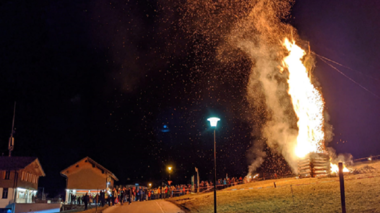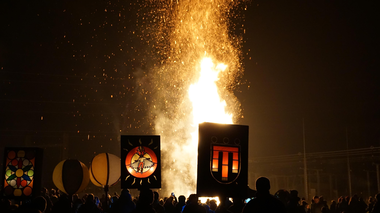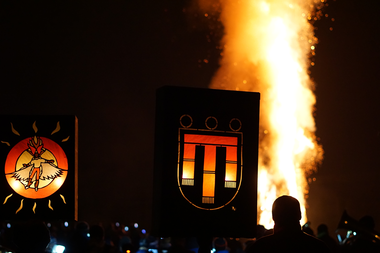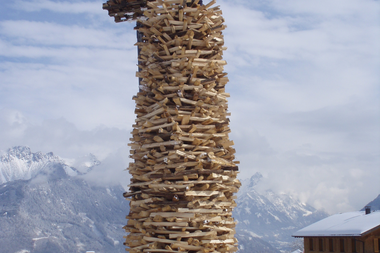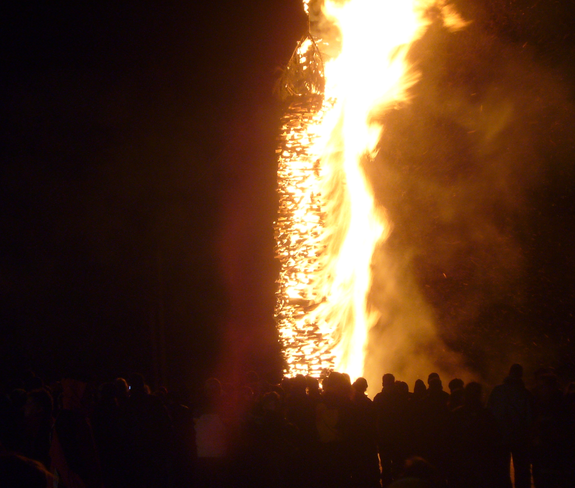
From mystical traditions
The sparking fire
If you are out and about in Vorarlberg on the first weekend after Ash Wednesday, you will be amazed to see burning wooden towers and impressive bonfires everywhere. In Bürs, at the entrance to the Brandnertal valley, even glowing lanterns are carried through the village. Top hat and tailcoat wearing "Funkabuaba" march festively through the village - at the end a blazing fire is lit.
What is this spectacle all about?
The traditional burning of sparks is an ancient Swabian-Alemannic tradition whose origins are not fully understood. Some may think that the burning of wooden towers and witch dolls is a remnant of the terrible witch burnings of the early modern era, but this is a misconception! The origins of the fires can be found in ancient pagan fertility rites with sacrificial fires, as well as in the end of the Swabian-Alemannic carnival and the beginning of Lent. In Vorarlberg, the practice of Bonfire Sunday has a long tradition; in almost every municipality, a bonfire is organized by the local spark guild, the local fire department or the carnival guilds. In 2010, Vorarlberg's Spark Sunday was even included in the World Cultural Heritage List.
Every year on Spark Sunday, the so-called spark fir is lit. This is a piled-up wooden tower made from collected materials, such as old Christmas trees. According to popular belief, the sparks are supposed to drive away winter and ignite happiness. The winter witch, which is attached to the top of the spark, symbolizes the beginning of spring. It is usually prepared with black powder so that it can explode in the fire. Once the spark is lit, the spark master gets nervous... and not without reason! He waits for the witch to explode - if this doesn't happen, she has to be buried the next day.
In Vorarlberg, Spark Sunday has a second name: "Küachlisunntig" - the name says it all! The delicious little cakes made from yeast dough, refined with powdered sugar, not only make the hearts of Funkenzunft members beat faster. Funkaküachli are a must when visiting the Funken - and if you can't get enough of them, you can easily bake them at home - click here for the recipe.
There are numerous exciting customs surrounding the Funkenfeuer, which are carried out differently in each valley - and even in the individual villages.
In Bürs, the PUMA are on the loose!
In the municipality of Bürs, there is a very special tradition that is passed down from generation to generation: the Puma. However, the Bürs Puma has nothing to do with its namesake, the Puma, but rather comes from the word "Pumerantscha", which means oranges. Pumas are lanterns that originally looked like oranges in their round shape. They are decorated with candles and carried festively through the village during the Puma procession on Funken Sunday. And when the Puma aren't lighting up Bürs, they slumber in Roland Rettenberger's attic. Roland Rettenberger is the so-called "Puma master". He looks after 47 different specimens, which are put on display every year. His family has been preserving and restoring the pumas for generations. The lanterns are available in a round shape, as rectangular lanterns or as large "box pumas". The Puma motifs are cut out of cardboard, backed with colorful transparent paper and glued onto a wooden frame. The oldest puma is "Genoveva" from 1892.
Stacking logs according to old tradition!
In Bürserberg and Brand, the sparking tower is not built with pallets and Christmas trees as in other communities. The special construction method of the spark has been a tradition for many years. Logs are stacked high without using a single nail or other fastener.
In Bürserberg, the fir wood is straightened and stacked the previous year so that it dries properly. In the middle of the tower, the 20m-high spruce is erected, which is initially encased in small round logs as a platform. The dry logs are then stacked in an octagon on the platform and finally covered with fir brushwood. In Bürserberg, the schoolchildren also build wooden torches, which they swing in the dark night sky before lighting the sparks. Afterwards, fireworks are shot into the night sky and the spark tower is set alight.
